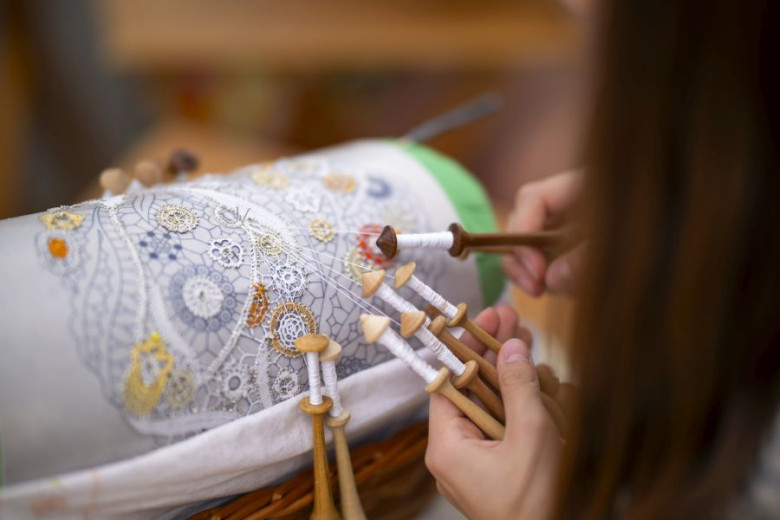Date: 14. June 2025
Time to read: 2 min
The mystery about the origins of and first attempts at lacemaking in Slovenia still remains hidden in the threads of history. The Glory of the Duchy of Carniola from 1689 is still considered the oldest written record about lace-making in Slovenia, and it states: "Here in Ljubljana, different Dutch and Venetian lace is made and sent to many lands, and peddlers take them to faraway places."
In addition to Ljubljana, bobbin lace was also made in the 17th and 18th centuries in Idrija, Logatec, Radovljica and Kamnik and their surroundings. In the 19th century bobbin lace-making spread to Idrija’s surroundings, Cerkno, the Trnovo Forest Plateau, part of the Slovene Littoral and to Poljane and Selca Valleys. As many as 159 Slovenian towns were making bobbin lace by the end of the 1920s.
Vocational training significantly affected the development of lace-making. The first lace school was founded in 1763 in Ljubljana.
At the end of the 19th and beginning of the 20th centuries the following towns established their own lace schools: Idrija (1876), Izola (1883), Soča (1884), Otlica (1885), Bovec (1887), Čepovan (1891), Cerkno and Horjul (1900), Žiri and Polhov Gradec (1906), Železniki (1907), Gorenja vas, Sovodnje ob Soči and Veliki Dol (1909). The knowledge of bobbin lace-making was also spread by oral tradition from generation to generation. In addition to women, men and children also made bobbin lace at the end of the 19th century and the first decades of the 20th. Bobbin lace-making was an important source of income for large families in those times.
Lace-making today is one of the most widespread crafts in Slovenia, practised in 129 locations across the country. There are as many as 119 active bobbin lace-making societies, sections and groups. Lace schools in Idrija, Žiri and Železniki and their branches educate more than 700 students aged between six and 15 every year.
Bobbin lacemaking is an elective subject at 12 primary schools in eight other towns, and is chosen by more than 300 students aged 13 to 15. In addition to this, more than 400 students take up bobbin lace-making as part of their extra-curricular activities at 34 primary schools, or even as an after-school activity in 28 towns across the country.
It is losing its historical role as a source of (additional) income, and is becoming more of a leisure activity that inspires people to engage in handicrafts, socialise and relax. The intertwining of threads is also a creative challenge and means of expression for Slovenia’s fashion designers, designers, architects and other artists. Lace also inspires artists in music, literature, and dance.
The Idrija bobbin lace-making was added to Slovenia’s List of Registered Elements of Intangible Cultural Heritage in 2013, while Slovenian bobbin lace-making followed in 2015. Both elements were declared a cultural monument of national importance in 2016. Bobbin Lacemaking in Slovenia was in 2018 inscribed on the UNESCO Representative List of the Intangible Cultural Heritage of Humanity.
-
 The theme of the 43rd Idrija Lace Festival was "Bee-inspired Connections". Photo: Robert Zabukovec/Arhiv Zavoda za turizem Idrija
The theme of the 43rd Idrija Lace Festival was "Bee-inspired Connections". Photo: Robert Zabukovec/Arhiv Zavoda za turizem Idrija
-
 In Idrija, bobbin lace has been crafted for centuries, using traditional wooden sticks, known as "klekeljni". Photo: Robert Zabukovec/Arhiv Zavoda za turizem Idrija
In Idrija, bobbin lace has been crafted for centuries, using traditional wooden sticks, known as "klekeljni". Photo: Robert Zabukovec/Arhiv Zavoda za turizem Idrija
-
 Beautiful dresses can also be made of or decorated with Idrian lace. Photo: Robert Zabukovec/Arhiv Zavoda za turizem Idrija
Beautiful dresses can also be made of or decorated with Idrian lace. Photo: Robert Zabukovec/Arhiv Zavoda za turizem Idrija
-
 Not just adults, but also schoolchildren can learn lace-making. Photo: Robert Zabukovec/Arhiv Zavoda za turizem Idrija
Not just adults, but also schoolchildren can learn lace-making. Photo: Robert Zabukovec/Arhiv Zavoda za turizem Idrija
-
 Wooden sticks "klekeljni" hold cotton or linen threads. Photo: Robert Zabukovec/Arhiv Zavoda za turizem Idrija
Wooden sticks "klekeljni" hold cotton or linen threads. Photo: Robert Zabukovec/Arhiv Zavoda za turizem Idrija
-
 The slogan of the 43rd Idrija Lace Festival "Bee-inspired Connections" links the art of lacemaking to the beekeeing heritage. Photo: Robert Zabukovec/Arhiv Zavoda za turizem Idrija
The slogan of the 43rd Idrija Lace Festival "Bee-inspired Connections" links the art of lacemaking to the beekeeing heritage. Photo: Robert Zabukovec/Arhiv Zavoda za turizem Idrija











